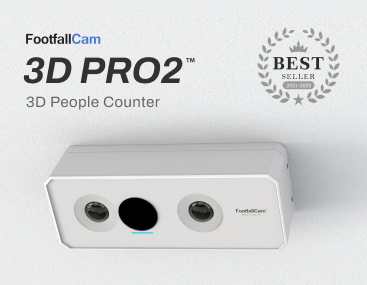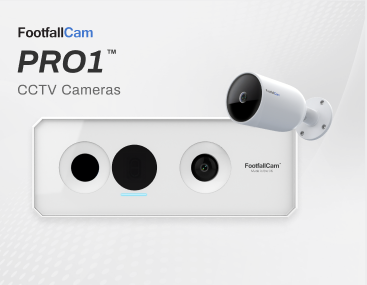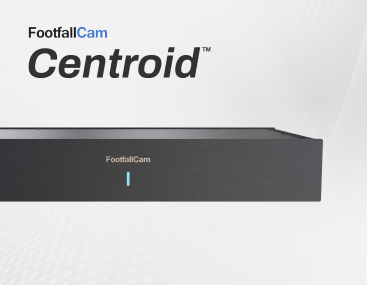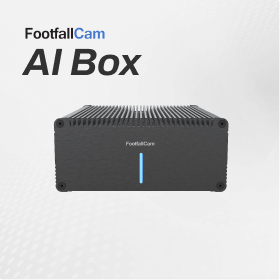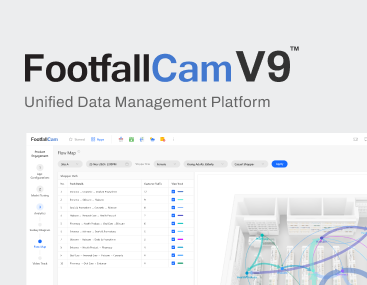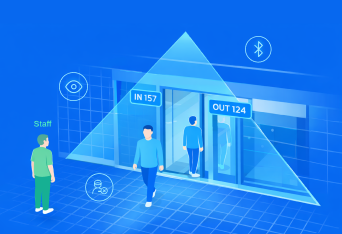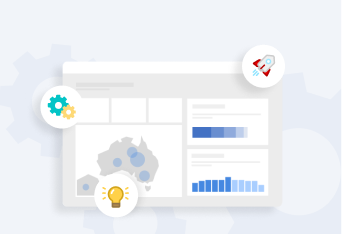Glossary / Definition of Terms
Find out moreWhat are the definitions of these glossary terms within the context of people counting systems?
Accuracy
Accuracy: to characterise how well a device detects and counts targets in a variety of settings with fluctuating pedestrian traffic volumes, as well as how well bi-directional counters maintain a balance between "in" and "out" counts in the field of people counting.
Anonymise
Anonymise: to carry out a procedure such that privacy is maintained. a procedure that is frequently necessary when employing video-based counters to safeguard the identification of individuals entering a counting zone. The FootfallCam 3D people counters have this feature built-in.
Automatic visitor counter
Automatic visitor counter: a tool that eliminates the need to manually tally site visits. A visitor counter that is automated keeps track of and reports on the number of persons entering or exiting a location.
BACnet
Building Automation and Control Networks (BACnet): an ISO standard for connecting BMS devices and controllers via a BMS-specific network. This makes it possible to assess HVAC consumption and realise significant efficiency gains by centrally controlling and monitoring HVAC.
Bi-directional footfall
Bi-directional footfall: the capability of a people counting device to tally individuals moving in both directions.
Building Energy Management: aids commercial enterprises in decreasing carbon emissions and energy consumption. These solutions regulate and oversee HVAC (Heating, Ventilation, and Air Conditioning) systems, and frequently include lighting control as well. By employing people counters and schedules to monitor both current and projected space utilisation, we can integrate these counters with HVAC systems to enhance efficiency. Consequently, it becomes feasible to illustrate energy consumption per individual rather than per square metre of commercial space.
Building Information Modelling (BIM): involves the incorporation of People Counting data alongside various other metrics to aid in the generation and management of digital representations detailing the physical and functional attributes of a facility. These models are shared to facilitate decision-making regarding a facility's lifecycle, spanning from initial conceptualisation, through design and construction, to its operational phases.
Building Management System (BMS): a computerised control system implemented in buildings to regulate and supervise mechanical and electrical equipment, including ventilation, lighting, power systems, fire systems, and security systems. They comprise of software and hardware controllers interconnected via a network, often using the BACnet protocol. People counting system can enhance the efficiency of a Building Management System by assisting in energy management through occupancy-based control of specific zones within the building.
Conversion Rate: the ratio of individuals passing by a store to individuals entering the store or the ratio of individuals making purchases to the total foot traffic within a specified timeframe.
Count Lines: the lines set up around an entrance or exit, designed to optimise the duration for tracking by thermal or video people counters. The objective is to extend tracking time while reducing inaccuracies caused by objects, merchandise, or customer movements within the counting area.
Counting Zone: the particular region observed by a footfall counter or the overall area encompassed by footfall counters spanning each pedestrian entrance.
Customer Conversion - refers to either the number of people passing a retail outlet who enter the store or the number of people who have made a purchase compared to the footfall in a given period. The first is shown as a ratio or percentage from the equation: Passing Traffic / Footfall, the second is shown as a ratio or percentage from the equation: Sales Transactions / Total Footfall
Customer Counter: a tool used to monitor the number of customers visiting a business. The data obtained from this device can grasp conversion rates and inform business decisions.
Customer Counting: using people counting technology as a way to track the number of visitors they attract.
Customer insight: involves gathering, utilising, and analysing data that enables a business to attract, nurture, comprehend, and retain its customer base. Footfall data provides crucial insights for businesses to gain deeper understanding into customer behaviour.
Customer traffic: commonly known as customer flow, denotes the number of customers who visit a retail store.
Desk Sensors: PiR sensors positioned on or near workplace to monitor occupancy and gather usage data.
Dwell Time: the duration an individual remains within a particular area. Bi-directional footfall counts and calculations based on the mean occupancy within a specified timeframe can be used to calculate average dwell time. Employing customer tracking technology allows for more detailed analysis of dwell time for individual visitors.
Electronic People Counter: an electronic equipment that detects and counts the number of people entering or exiting a location. There are various methods, such as break beam systems, thermal signature recognition and 3D video technology.
Event Counting: tracking the number of visitors at an event, aiming to assess interest in the event, or to aid in health and safety measures and crowd management.
Event Management: an organised planning, preparation, and supervision of various elements that can influence an event and the behaviour of the crowd. Effective event management involves evaluating the capacity of a venue to handle visitors beforehand. This involves assessing projected and actual crowd sizes, providing clear signage indicating entry and exit points, ensuring adequate staffing levels, and establishing well-defined and communicated emergency evacuation protocols.
Event Occupancy: the number of visitors present at an event, which may span across multiple buildings or areas. Additionally, it may also refer to the projected maximum capacity of visitors who can attend an event, commonly used for event planning.
Flow accuracy: the accuracy of counting foot traffic moving in a single direction by a people counter.
Footfall: the number of people entering a shop, business, site, or space within a specific timeframe. It serves as a significant metric for assessing the effectiveness of a company's advertising efforts in attracting people to its establishments.
Footfall Comparison: enables users to evaluate historical footfall trends or compare the performance of various sites across different time periods by comparing footfall counts.
Footfall Counter: An electronic device used to quantify foot traffic, which is the number of people entering and exiting a location. There are various methods, such as break beam systems, thermal detection, and video detection.
Footfall Reporting: The data generated by footfall counting devices, formatted into actionable information to aid in making business decisions.
Free Flow Event: an event where the fans can move between different zones freely, which may potentially lead to overcrowding. Employing people counters to monitor visitor flow rates can assist in forecasting when a zone is likely to reach maximum occupancy. This helps the event control team implement flow management measures pre-emptively, preventing overcrowding.
Frequency: the rate at which a room or space is used within a specific timeframe.
Group Counting: a sophisticated people counting algorithm capable of determining the potential relationships among visitors by analysing their proximity to each other and the trajectory they follow through the counting zone.
Increase Retail Conversion Rate: A common goal for retailers aiming to enhance their sales performance. Achieving this can involve strategies such as driving more foot traffic into the store, increasing the average purchase size of each customer, or ensuring that customers receive excellent customer service, thereby encouraging them to make a purchase. Increasing the retail conversion rate means maximising the number of sales per potential customer who enters the store. Even a slight improvement in the retail conversion rate can yield significant benefits for the overall profitability of the business.
Live Event Occupancy: the current number of visitors present at an event at a specific moment in time. Automated people counting systems enable organisations to monitor their live event occupancy in real-time throughout the day.
Live Occupancy Counting: using electronic people counters to gain real-time occupancy and visitor flow rate displays, presenting data within 10 seconds of visitors passing through a counting zone.
Live People Counting: using people counting technology to generate nearly real-time data on foot traffic, as they enter or exit a certain area.
Marketing Performance Measurement and Management (MPM): a term used by marketing professionals to describe the assessment and enhancement of the efficiency and effectiveness of marketing efforts. This involves aligning marketing activities, strategies, and metrics with business objectives. It includes establishing a metrics framework to monitor marketing performance, and employing marketing dashboards to manage it. The focus is on evaluating, overseeing, and analysing marketing performance to maximise effectiveness and optimise return on investment (ROI). Data, analytics, and metrics are crucial elements in managing marketing performance. While brand recognition may be a part of marketing objectives, for retailers, an increase in sales and profits serves as the primary ROI indicator. However, solely an increase in sales transactions does not provide a comprehensive view of a marketing campaign's effectiveness. For instance, if sales transactions rise by 10% while store footfall increases by 100%, it indicates high campaign effectiveness, but other factors may diminish potential ROI. Hence, incorporating footfall metrics from people counters into MPM is essential for understanding the true effectiveness of a marketing campaign.
Missed Opportunities: potential customers who visit a store but leave without making a purchase due to many reasons, such as long queue lengths or wait times, insufficient staff availability, pricing, or product availability issues.
Occupancy: the total number of people in an area. It is calculated by subtracting the total number of 'out' counts from the total number of 'in' counts at any given time. Alternatively, it can be determined using FootfallCam people counting technology, which can analyse the total number of people within the detection range of the counter.
Occupancy Accuracy: achieved by using overhead counters with precise and consistent flow-rate accuracy. However, achieving this accuracy can be challenging due to inherent slight inaccuracies present in all existing people counting technologies. These inaccuracies can accumulate, especially in scenarios with low maximum capacities, short average dwell times, high footfall, and high-volume traffic flow rates. To address this, FootfallCam diligently monitors counter accuracy under various conditions and adjusts the relevant factors for 'in' or 'out' counts to mitigate potential errors. This ensures a balanced approach and enables clients to understand the expected tolerance of the system, thus facilitating decision-making based on reliable data.
Occupancy Management: leveraging data obtained from visual sources, CCTV, and people counting equipment to aid decision-making and implement procedures aimed at regulating visitor flow and maintaining occupancy levels of venues with predetermined maximum capacities.
Occupancy Tracking: tracking the number of people present in a building, space, or area, and monitoring how this quantity fluctuates over time.
Occupant-Centric Scenario Modelling for Energy Management: using FootfallCam People Counting 'Smart Building' Space Management solutions enables businesses to grasp energy usage in buildings on a per person basis rather than per square metre
Office Space Management: implementing systems to enhance the efficient utilisation of desks and meeting rooms within office premises. Strategies such as Hot-desking and Hoteling are employed to optimise the ratio of staff to desks. FootfallCam offers desk sensors capable of monitoring desk utilisation by tracking activity at individual desks, within departments, or across building floors.
Over-counting: occurs when the people counters count a higher number of people than the actual count. This may be due to the factors such as environmental conditions, inadequate configuration, unforeseen staff, or customer behaviour within the counting zone.
Passing Traffic: the number of people walking past a particular site. For instance, for a retail store situated on a high street, passing traffic includes pedestrians passing by the front of the store on the street outside. Traditional automated people counting methods, such as beam or overhead counters, find it challenging to measure passing traffic accurately. However, passing traffic can be quantified using Wi-Fi tracking technology installed in the store. This technology anonymously tracks the signals emitted from mobile devices and distinguishes, based on signal strength, whether they are within the store or passing by on the street outside.
People Counter: an electronic device designed to detect and count the number of people.
People Counting: the process of collecting footfall data on visitors and customers.
People Counting Software: a program that aggregates data from people counting devices to generate footfall data reports.
Power over Ethernet (PoE): a technology that enables the transmission of electrical power, along with data, safely over CAT5 or CAT6 Ethernet cabling, which FootfallCam Pro2 supports it.
Real-Time Counting: the capability of counting and showing live footfall or occupancy counts within 5 seconds of the target passing through a count-zone.
Refining Operating Hours: analysing customer traffic and sales transactions in comparison to staffing expenses and other expenses related to maintaining site operations. This analysis helps determine profitable times for keeping a site open and when it is preferable to close due to limited customer potential. Evaluating footfall and passing traffic provides a more accurate measure for setting opening hours and maximising sales.
Remote Monitoring: a service provided by FootfallCam aimed at ensuring that our clients' people counters are connected to the network and operating properly. This service automatically detects any connectivity issues and can identify specific accuracy issues. Additionally, remote access to people counters allows FootfallCam engineers to log in and inspect the view of the counting zone, enabling manual assessment of counter accuracy.
Retail Footfall: the number of potential customers in a retail environment. It can be used to compare with sales figures to calculate conversion rates.
Retail Footfall Index: a comparison of footfall statistics gathered from various sites across a country.
Retail Metrics: the data that can be analysed and synthesised to provide a better understand into customer behaviour, marketing effectiveness, and store and staff performance. Footfall data serves as a vital metric in assisting retailers in comprehending their business's strengths and areas for improvement.
Sales Conversion (ratio): the ratio of visitors to a retail store who actually make a purchase to the ratio of total amount of visitors to a retail store.
Shopper Tracking: the ability to track the paths taken by individual customers or creating a heat map that illustrates the most frequented paths within a retail environment and the primary areas of interest where customers spend significant time browsing.
Staff Planning: the process of planning the staff composition to meet business objectives and provide a high level of customer service to maximise sales conversion rates in retail and customer satisfaction in service industries. The footfall data can be used to forecast peaks and troughs in customer numbers, enabling businesses to minimise staff expenses during low footfall periods and optimise customer service and profitability during high footfall periods, where inadequate staffing might otherwise compromise customer service.
Stereoscopic: utilises two lenses to enable the creation of three-dimensional vision, resulting in images with depth and shape. Stereoscopic video counters, such as FootfallCam Pro2, leverage this capability to achieve more precise people counting.
Time of Flight Footfall Counter: These counters emit infrared light pulses. By measuring the slight variations in the time it takes for the light to return to the counter after bouncing off surfaces, devices like the FootfallCam 3D Mini can construct a highly precise distance map of the area below.
Traffic Density: the number of people passing through a specific area under a people counter at any given time.
Traffic Patterns: the historical highs and lows in footfall rates.
Under-counting: occurs when the people counters count a fewer number of people than the actual count. This is a weakness when Beam Counters are deployed across a broad entrance. However, both thermal and video counters can also experience under-counting, especially when there is high level of traffic density. Consistent under-counting can be addressed by applying a correction factor to each set of counts, such as adding 10% to the daily footfall count.
University Space Management: a system used by FootfallCam that utilises various people counting technologies installed in classrooms and other significant student areas within universities. Its purpose is to collect data on occupancy and usage rate, and to calculate precise space utilisation data.
Utilisation: the measurement of how effectively a space is being used. It involves analysing the average occupancy of a room and how frequently the room is utilised.
Velocity Filter: an algorithm in people counting systems that identifies and filters targets based on their speed of movement through the counting zone.
Venue Occupancy: the maximum number of people that a venue can accommodate.
Footfall: the number of people entering a shop, business, site, or space within a specific timeframe. It serves as a significant metric for assessing the effectiveness of a company's advertising efforts in attracting people to its establishments.
Video Counting: using video technology to count people or objects. Systems based on CCTV typically incorporate supplementary software features with background processing, susceptible to environmental influences, often leading to inconsistent or inaccurate counts. More specialised video counters employ onboard processing, delivering improved accuracy. Nonetheless, the majority of single-lens video counters struggle to achieve desirable levels of accuracy or consistency.
Video Validation: a feature that enables the recording of a video stream alongside footfall data, allowing for the retrieval of video footage, stored count data, and diagnostic information through a single IP data stream. This feature is available on all FootfallCam 3D people counters, including the FootfallCam Pro2 and FootfallCam Extend models
Visitor Counter: a device specifically created to count the number of people entering or exiting a public venue.
Weather Effect: the impact that weather conditions have on footfall trends across different sites, depending on factors such as their purpose, inventory, and location. For example, footfall may increase on a rainy day at a sheltered shopping centre or stores selling umbrellas, but decrease for typical high street shops. The influence of weather on footfall varies depending on the nature and location of each site. By evaluating the impact of weather on footfall, managers can anticipate the quantitative traffic response and make appropriate staffing adjustments.
Workforce Management: the process of scheduling staff hours to maximise the utilisation of office space, particularly in environments employing hot-desking, flexible workspaces, and break-out areas. Alternatively, it can mean that scheduling staff to enhance sales conversion in a retail environment.
Workspace Management: using people counters to gain peaks and troughs in office occupancy throughout each day, week, and month, illustrating the percentage use of an office space compared to its designated capacity to aid in managing office spaces. Traditionally, office space management analysis relies on anecdotal evidence or manual counts, which are labour-intensive and offer only a snapshot of actual usage levels. Given the high cost associated with running a single office workstation, many organisations seek to consolidate space. People counters offer an objective, consistent, and comprehensive overview over time, providing reliable data for managing desk space and informing business decisions regarding the consolidation or expansion of premises efficiently.
A People Counting System measures the number of visitors entering or leaving a space such as a retail store or airport. FootfallCam’s 3D stereo cameras deliver 99% accuracy even under challenging lighting, providing real-time traffic data. Businesses use this data to optimise staffing, evaluate store performance, and forecast demand, forming the foundation of wider analytics such as dwell time, conversion, and occupancy.
Staff Productivity Analytics evaluates workforce efficiency by comparing staffing levels with customer engagement and sales outcomes. FootfallCam integrates footfall and sales data to identify overstaffing or gaps, enabling fair performance assessment. Managers gain insights into service coverage, allowing improved labour allocation and training initiatives that enhance productivity.
Standard Operating Procedure (SOP) Adherence Monitoring tracks whether daily operational routines, such as cleaning and opening duties, are followed. FootfallCam’s AI detects deviations and generates compliance reports, helping maintain consistent standards across all sites. Managers can measure adherence rates and improve staff accountability while safeguarding service quality.
Queue and Service Optimisation measures waiting time and queue formation in real time. FootfallCam’s AI sensors detect crowding and notify managers before bottlenecks occur, allowing proactive staff redeployment. This helps reduce waiting times, improve customer satisfaction, and uphold service efficiency across locations.
Occupancy and Staffing Balance analysis compares visitor density with available staff to ensure efficient operations. FootfallCam’s dashboard visualises live occupancy, helping managers redeploy employees dynamically during peak hours and identify underutilised resources during quieter periods.
Labour Forecasting predicts staffing requirements by analysing historical footfall and seasonal trends. FootfallCam’s predictive models generate accurate rotas, balancing cost efficiency and customer service. This approach prevents understaffing during busy periods and excessive labour costs during low traffic hours.
The Shift Optimisation Engine automates scheduling by aligning predicted customer flow with employee availability. FootfallCam’s AI-driven tool reduces planning time, ensures legal compliance, and enhances fairness in workload distribution, improving morale and productivity.
The Employee Engagement Index measures how actively staff interact with customers. FootfallCam analyses activity zones to quantify engagement, allowing managers to recognise high performers and coach underperforming teams. The result is better service quality and team motivation.
The Service Compliance Tracker validates operational consistency by monitoring store opening times, counter readiness, and staff positioning. FootfallCam’s reports ensure each site adheres to company policies, maintaining reliability and customer satisfaction.
Productivity Benchmarking compares performance across sites using metrics such as sales per visitor and labour efficiency. FootfallCam standardises KPIs to identify top performers and areas requiring improvement, fostering continuous operational excellence.
Promotion Effectiveness Analysis measures how marketing campaigns influence visitor traffic and sales. FootfallCam correlates campaign periods with changes in conversion and dwell time to reveal the real ROI, helping marketers plan future promotions more effectively.
Sales Conversion Analytics assesses how many visitors make a purchase. By linking footfall data to POS transactions, FootfallCam helps identify stores with strong or weak conversion, guiding layout and staff adjustments to maximise sales.
Campaign Attribution Modelling determines which marketing channels generate genuine footfall increases. FootfallCam’s analytics separate natural traffic changes from promotional effects, improving budget allocation and campaign targeting.
Seasonal Trend Forecasting predicts traffic fluctuations caused by holidays, weather, or local events. FootfallCam’s AI forecasting assists businesses in adjusting stock, staffing, and promotions ahead of time, improving readiness and profitability.
Product Display Performance evaluates how effectively product zones capture shopper attention. FootfallCam’s heatmaps and dwell metrics help retailers identify which displays attract visitors, informing merchandising and layout decisions.
The Retail KPI Dashboard centralises performance metrics like conversion, queue length, and footfall into one platform. FootfallCam’s dashboard enables comparative reporting across stores, providing managers with insights into operational success and improvement areas.
Sales Uplift Modelling estimates the incremental sales attributed to specific campaigns or layout changes. FootfallCam’s analytics identify genuine growth versus baseline trends, ensuring accurate ROI measurement.
Campaign Timing Optimisation determines the best periods to launch promotions based on historical visitor patterns. FootfallCam helps maximise exposure and engagement, improving campaign efficiency and return on investment.
Multi-Channel ROI Measurement analyses how digital, in-store, and outdoor campaigns collectively affect visitor traffic. FootfallCam integrates with marketing data to quantify combined impacts and guide future investments.
Brand Engagement Analytics measures visitor interaction with brand zones or experiential displays. FootfallCam uses dwell and re-visit metrics to quantify brand impact and strengthen in-store experience strategies.
Prescriptive Analytics transforms predictive insights into recommended actions. FootfallCam’s system uses optimisation algorithms to recommend staffing levels, queue thresholds, and opening hours that maximise efficiency and profitability. By simulating operational scenarios, businesses can act with confidence, supported by reliable, data-driven recommendations.
A Causal DAG maps the relationships between variables such as pricing, staffing, and sales outcomes. FootfallCam employs causal graph modelling to differentiate correlation from causation, ensuring operational changes are based on genuine drivers rather than coincidence. This helps decision-makers focus resources where they truly deliver impact.
Causal Inference Simulation enables businesses to evaluate potential outcomes before implementing changes. FootfallCam’s analytics simulate various scenarios - such as altering staffing levels or promotion timing, to predict the likely effects on sales and customer satisfaction, empowering managers to take calculated actions.
Business Scenario Planning visualises possible outcomes from different strategic decisions. FootfallCam’s simulation workspace helps management anticipate the results of changes to staffing, store layout, or promotional strategy, enabling proactive planning and effective resource deployment.
Uplift Modelling measures the additional effect of a specific intervention such as a marketing campaign or new display. FootfallCam’s uplift models isolate the true improvement caused by the action, providing clearer evidence for ROI calculations and future marketing decisions.
Counterfactual Analysis examines what might have happened had a different decision been made. FootfallCam applies this technique to test hypothetical outcomes, allowing businesses to compare actual performance against alternative strategies and refine decision-making over time.
The Prescriptive Staffing Model combines predictive demand data with cost optimisation algorithms to recommend ideal staffing levels. FootfallCam’s system ensures every store maintains service quality without excessive labour costs, supporting better profitability and employee satisfaction.
FootfallCam’s Predictive Pricing Engine analyses elasticity between pricing and visitor demand. By understanding how price adjustments affect footfall and sales, retailers can identify optimal pricing strategies that increase turnover while maintaining customer engagement.
Causal Reinforcement Learning combines AI learning with causal inference to refine business strategies continuously. FootfallCam’s algorithms adapt to changing environments, improving the precision of predictions for staffing, layout design, and marketing investment.
The Retail Simulation Sandbox offers a digital testing environment where managers can model layout or staffing adjustments without disrupting operations. FootfallCam enables teams to experiment safely and predict the likely impact before applying real-world changes.
AI-Based Theft Detection identifies unusual movements or behaviour patterns suggestive of potential theft. FootfallCam’s intelligent algorithms analyse customer flow to detect reverse traffic or loitering near exits, helping reduce shrinkage and protect profits.
On-Device AI allows analytics to be processed locally, minimising latency and preserving privacy. FootfallCam’s Centroid and Pro2 devices incorporate built-in AI processors to deliver rapid, secure analysis without relying on cloud infrastructure.
A Neural Processing Unit (NPU) is a dedicated chip for accelerating AI computations. FootfallCam’s use of NPUs ensures faster model execution, lower power consumption, and greater accuracy, enabling advanced features such as vision-language inference and behaviour recognition.
Vision-Language Models combine image recognition with language understanding. FootfallCam’s VLM applications interpret complex in-store events such as browsing, queueing, or product engagement, unlocking richer behavioural analytics.
The AI Orchestration Engine coordinates multiple analytics modules - from counting to predictive alerts, ensuring smooth, efficient operation. FootfallCam’s orchestration layer automates workflows and ensures consistent analytics delivery across all devices.
Model Drift Monitoring detects when AI model accuracy declines due to environmental or behavioural change. FootfallCam continuously retrains and updates its algorithms to maintain long-term accuracy in dynamic environments.
FootfallCam’s Adaptive Learning Engine improves detection models over time by incorporating feedback from real-world data. This process ensures ongoing accuracy, even as store layouts or lighting conditions evolve.
Edge-Cloud Synchronisation ensures reliable communication between devices and central servers. FootfallCam’s hybrid data architecture enables local analytics continuity while maintaining synchronised dashboards for multi-site management.
The Vision AI Ethics Framework outlines FootfallCam’s approach to responsible AI usage. It ensures data is processed fairly, anonymously, and transparently, supporting customers’ compliance and ethical standards.
FootfallCam’s AI Scalability Framework ensures consistent analytics performance across thousands of devices globally. This framework manages load balancing, version control, and deployment automation for reliable enterprise-scale AI analytics.
Store Ranking Analytics compares performance across branches using metrics such as sales conversion, dwell, and service quality. FootfallCam enables fair benchmarking, identifying successful practices to replicate across other locations.
Staff Allocation Optimisation determines how best to assign personnel across departments or time slots. FootfallCam’s models recommend efficient distribution based on forecasted demand and historical trends.
The Service Quality Index consolidates metrics such as waiting time, queue management, and service coverage to provide a performance benchmark. FootfallCam’s dashboards track improvement efforts and customer experience quality.
Store Compliance Analytics monitors adherence to operational and branding guidelines. FootfallCam provides evidence-based reporting to ensure uniform execution across all sites, strengthening brand integrity.
Operational Cost Benchmarking evaluates cost per visitor by analysing energy use, staffing, and occupancy data. FootfallCam identifies high-cost stores and highlights efficiency opportunities for better resource control.
Predictive Maintenance analyses device performance to predict failures before they occur. FootfallCam’s predictive tools schedule proactive servicing, reducing downtime and maintenance costs.
Footfall-to-Sales Correlation measures the relationship between visitor volume and revenue. FootfallCam helps identify stores that underperform or overachieve relative to traffic, supporting targeted interventions.
Sales Funnel Analytics visualises conversion stages from entry to purchase. FootfallCam’s tracking data reveals drop-off points, helping optimise store design and staff focus for greater conversion rates.
The Store Productivity Index aggregates multiple operational KPIs, such as conversion, queue length, and dwell, into a single efficiency score, providing a clear performance overview.
Demand Elasticity Modelling examines how changes in price or promotions influence customer behaviour. FootfallCam’s causal models guide pricing strategy and promotional planning for optimum financial performance.
Store Location Intelligence evaluates potential sites based on demographic and visitor data. FootfallCam’s analytics guide site selection decisions by highlighting high-traffic, high-potential areas.
Omnichannel Behaviour Analytics connects online and offline interactions, revealing how digital engagement translates into store visits. FootfallCam helps retailers understand and optimise cross-channel experiences.
The Customer Retention Indicator measures how often customers revisit a store. FootfallCam uses re-identification metrics to assess loyalty, helping retailers design effective retention programmes.
Leadership Dashboards present summarised key metrics for executive review. FootfallCam’s dashboards visualise regional performance, enabling fast, informed strategic decisions.
Brand Equity Measurement assesses emotional engagement and long-term loyalty through repeat visit and dwell analytics. FootfallCam quantifies brand strength using behavioural data.
Revenue per Visitor Index calculates the average spend per visitor. FootfallCam links visitor flow to POS data, giving precise insight into store performance efficiency.
Visitor Flow Optimisation redesigns store layouts based on path tracking data. FootfallCam’s analytics identify congestion zones and optimise movement for smoother customer journeys.
The Staff Engagement Score evaluates employee interaction and attentiveness towards customers. FootfallCam’s heatmaps show engagement density to improve training and motivation.
Store Resilience Modelling tests how effectively stores cope with disruptions such as staff shortages or supply issues. FootfallCam simulations identify weak points and prepare contingency strategies.
Customer Segmentation Analytics categorises visitors by behaviour or frequency. FootfallCam identifies patterns such as regular, occasional, or new customers, allowing tailored marketing actions.
Predictive Campaign Planner forecasts expected campaign performance. FootfallCam’s causal models estimate ROI before launch, supporting smarter budget allocation.
The CLV Estimator predicts long-term revenue per customer using behavioural analytics. FootfallCam enables retailers to prioritise loyalty programmes that drive sustained profitability.
Loyalty Engagement Analytics monitors repeat visits and redemption activities. FootfallCam links in-store data with membership databases to assess the success of loyalty schemes.
In-Store Journey Heatmaps visualise where customers spend the most time. FootfallCam’s analytics reveal popular areas, assisting merchandising and layout optimisation.
Emotion-Aware Analytics interprets shopper sentiment through anonymous body language analysis. FootfallCam’s AI estimates satisfaction levels, supporting customer experience improvements.
Customer Satisfaction Estimation predicts perceived satisfaction by analysing dwell and queue time data. FootfallCam correlates waiting experiences with repeat visit rates to measure service quality.
Campaign ROI Dashboards consolidate promotion results, costs, and returns. FootfallCam enables real-time performance tracking across campaigns for faster decision-making.
Marketing Spend Efficiency Index assesses how effectively campaigns convert traffic into revenue. FootfallCam’s cross-channel attribution highlights which investments deliver true ROI.
Store Visit Attribution tracks how online marketing drives physical store visits. FootfallCam connects digital impressions with in-store traffic, bridging e-commerce and retail data.
Data Integrity Validation ensures accuracy and reliability of analytics outputs. FootfallCam’s automated checks identify gaps or anomalies, maintaining trustworthy insights.
Energy Efficiency Analytics correlates occupancy data with energy consumption. FootfallCam helps businesses optimise lighting and HVAC usage, reducing costs and emissions.
The Sustainability Footprint Index measures environmental performance across sites. FootfallCam’s data enables organisations to set measurable sustainability goals and monitor progress.
The Data Governance Framework defines consistent rules for data management. FootfallCam ensures privacy compliance and security, giving enterprise clients confidence in large-scale analytics use.
Edge Data Processing Compliance ensures processing adheres to regional privacy laws. FootfallCam’s edge-based AI analysis limits data transfer and improves legal conformity.
The Secure API Gateway facilitates safe data exchange between FootfallCam and partner systems. It ensures encrypted, authenticated communication for dashboards and integrations.
IoT Sensor Integration combines data from environmental and people-counting sensors. FootfallCam’s unified platform provides a holistic understanding of building usage.
Predictive Infrastructure Scaling forecasts system demand and allocates resources accordingly. FootfallCam’s adaptive architecture maintains performance as deployments grow.
Cloud-Native Analytics utilises scalable cloud environments to support extensive multi-site analysis. FootfallCam’s solution ensures global access and seamless updates.
Privacy by Design ensures data anonymity from the outset. FootfallCam’s architecture anonymises individuals and retains only aggregate data, ensuring compliance with global privacy regulations.
GDPR Compliance protects personal data within the European market. FootfallCam’s anonymisation, consent handling, and audit processes allow enterprises to deploy analytics responsibly.
Audit Trail Management logs configuration and data access activities. FootfallCam maintains traceability, supporting transparency and accountability in enterprise operations.
The Access Control Layer regulates permissions for various user roles. FootfallCam ensures that only authorised personnel can access analytics data, protecting confidentiality and compliance.
NVR/VMS Integration allows FootfallCam analytics to work seamlessly with existing surveillance systems such as Milestone, Genetec, or Hikvision. This approach extends the value of the customer’s current CCTV estate by enabling people counting, queue analytics, and theft detection through RTSP and standardised connectors, without replacing existing cameras. It reduces CapEx, accelerates pilot deployments, preserves centralised video management, and allows analytics to run at the edge or in the cloud.
The Balanced Scorecard translates strategy into measurable KPIs across four lenses: Financial, Customer, Internal Processes, and Learning & Growth. FootfallCam operationalises this by feeding accurate footfall, conversion, queue, dwell, and staff KPIs into a board-level scorecard. Financial views include Revenue per Visitor and labor ROI; Customer captures service quality and satisfaction proxies (queue time, dwell engagement); Internal Processes track SOP adherence and shrinkage; Learning & Growth monitors adoption of data-driven practices. Leaders get a single, comparable view across regions to evaluate promotions, staffing policies, and store design, closing the loop between strategy and shop-floor execution.
Shrinkage erodes margin through theft, process gaps, and unscanned exits. FootfallCam combines directional counting, path tracking, and event rules to flag reverse flows at gates, unusual linger near exits, and discrepancies between outflow and POS transactions. Stores can correlate alerts with staffing presence and camera clips to confirm incidents, adapt store layout (e.g., choke points), or change SOPs. Over time, dashboards quantify savings from interventions, building a defensible ROI case for security and operations alike. This term captures high-intent buyers searching for practical “AI theft detection,” “shrink analytics,” or “EAS alternatives.”
Airports and QSRs operate against strict service-level agreements: e.g., 80% of passengers cleared in under 10 minutes, or orders fulfilled within a set time. FootfallCam measures live queue length, waiting time distributions, and service throughput per counter, then scores performance against SLA targets by hour and daypart. Managers receive early warnings before breaches, can open additional lanes proactively, and can evidence compliance to authorities or franchise owners. Longitudinally, analytics identify structural causes of misses (layout, staffing patterns, flight banks, menu complexity) and quantify the benefit of fixes, turning SLA compliance into a competitive advantage.
When analytics rely on existing NVR/VMS estates, reliability matters. FootfallCam monitors stream availability, resolution changes, frame drops, and time sync to ensure analytics quality. Automated diagnostics separate network issues from camera faults and provide actionable tickets to the right team (installer, IT, or store ops). For multi-site enterprises, uptime rollups spotlight chronic problem locations and justify preventive maintenance. Ensuring stable video inputs raises counting accuracy, reduces gaps in KPI reporting, and protects the credibility of dashboards used by executives.
Daily routines shape customer experience: opening on time, activating counters, readying tills, clearing queues before close. FootfallCam converts these SOPs into measurable signals (first customer time, counter readiness, staff presence near critical zones), highlighting stores that repeatedly miss standards. Leaders can pinpoint whether issues stem from staffing, training, or layout and run targeted interventions. Over weeks, the analytics quantify improvement and its revenue impact (e.g., missed early traffic), translating operational discipline into tangible financial gains. This term meets practical searches like “store opening checklist analytics” and “measure SOP adherence.”
The Pioneer in People Counting Analytics
Founded in the UK in 2002, we've become the leading global provider of people counting solutions. Proudly an engineering firm, we specialise in utilising state-of-the-art technologies to create reliable, accurate, and useful people counting products.

